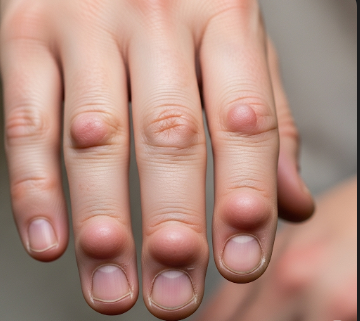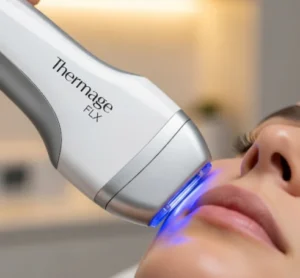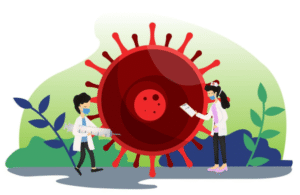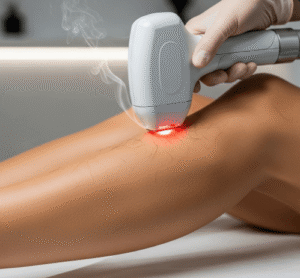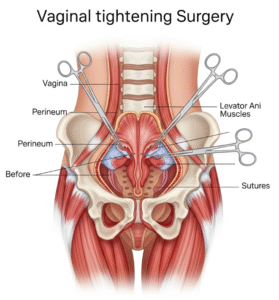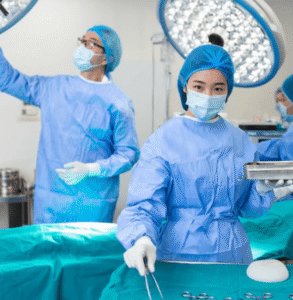Overview
Heberden’s nodes are bony swellings that appear at the distal interphalangeal (DIP) joints of the fingers. They are commonly associated with osteoarthritis, particularly in older adults, and are considered a clinical hallmark of degenerative joint disease in the hands.
These nodes are usually painless initially, but over time they can cause stiffness, reduced finger mobility, and cosmetic concerns. Although Heberden’s nodes are generally not life-threatening, they can impact daily activities like writing, gripping objects, or buttoning clothes.
In South Korea, advanced rheumatology and orthopedic clinics offer early diagnosis, conservative management, and surgical options for severe cases, ensuring optimal hand function and quality of life.
Key Facts
➲ Heberden’s nodes appear at the distal interphalangeal (DIP) joints of the fingers.
➲ They are a classic sign of osteoarthritis and often indicate degenerative joint changes.
➲ More common in women over 50, though men can also develop them.
➲ Nodes may be painful during flare-ups but are often painless over time.
➲ Can lead to stiffness, reduced hand dexterity, and deformity.
➲ In Korea, patients benefit from diagnostic imaging, physical therapy, and surgical interventions if needed.
What are Heberden’s Nodes?
Heberden’s nodes are bony enlargements at the distal joints of the fingers caused by osteophyte (bone spur) formation.
Key characteristics:
➲ Usually firm, hard nodules visible on the back of the fingers.
➲ Often bilateral and symmetrical, affecting multiple fingers.
➲ May develop gradually over months or years.
➲ Can cause limited joint flexibility and mild pain, especially during initial inflammation.
They are considered a physical manifestation of osteoarthritis and are often preceded by joint stiffness, mild swelling, and occasional tenderness.
What Symptoms Are Related to Heberden’s Nodes?
Symptoms may range from mild to functionally significant:
➲ Visible bony bumps at the DIP joints.
➲ Stiffness and reduced finger mobility, particularly in the morning.
➲ Occasional pain or tenderness during flare-ups.
➲ Swelling and redness in some cases.
➲ Difficulty performing fine motor tasks like writing, typing, or holding small objects.
➲ Joint crepitus or crackling sounds during movement.
➲ Over time, deformity or misalignment of the fingers may occur.
What Causes / Possible Causes
Heberden’s nodes primarily result from osteoarthritis, but multiple factors contribute:
1. Osteoarthritis
➲ Degenerative joint disease causing cartilage breakdown.
➲ Bone spur formation leads to visible nodules at DIP joints.
➲ Age-related wear and tear is the most common factor.
2. Genetic Predisposition
➲ Family history increases the likelihood of developing Heberden’s nodes.
➲ Women are more prone, suggesting hormonal or genetic influences.
3. Mechanical Stress
➲ Repetitive finger use, manual labor, or trauma may accelerate joint degeneration.
➲ Micro-injuries contribute to osteophyte formation over time.
4. Other Risk Factors
➲ Obesity – increases load on joints, contributing to osteoarthritis.
➲ Previous joint injuries or inflammatory joint conditions.
➲ Hormonal changes post-menopause, particularly in women.
When Should I See My Doctor?
Medical evaluation is recommended if:
➲ Pain or stiffness interferes with daily activities.
➲ Nodes develop rapidly or asymmetrically, which may indicate other joint disorders.
➲ There is significant swelling, redness, or warmth, suggesting inflammation or infection.
➲ Joint mobility is severely limited, affecting hand function.
➲ Conservative measures do not relieve pain or improve dexterity.
Early consultation allows for diagnosis confirmation, joint protection strategies, and appropriate management.
Care and Treatment
Treatment for Heberden’s nodes is primarily conservative, focusing on symptom management and maintaining hand function:
1. Lifestyle and Self-Care
➲ Finger exercises and stretching to maintain joint mobility.
➲ Splints or braces during flare-ups for pain relief.
➲ Activity modification to avoid repetitive strain.
➲ Heat or cold therapy for temporary pain relief.
2. Medications
➲ NSAIDs for pain and inflammation during acute episodes.
➲ Topical analgesics applied to affected joints.
➲ Occasionally, corticosteroid injections in severe cases.
3. Physical Therapy
➲ Hand therapy to strengthen muscles and improve dexterity.
➲ Occupational therapy for adaptation in daily tasks.
4. Surgical Intervention (Rare Cases)
➲ Joint surgery for severe deformity or loss of function.
➲ Options include arthroplasty, joint fusion, or osteophyte removal.
➲ Korea offers minimally invasive hand surgeries with rapid recovery.
Treatment Options in Korea
South Korea is renowned for advanced orthopedic and rheumatology care, providing comprehensive treatment for Heberden’s nodes:
Diagnosis in Korea
➲ X-rays to visualize joint space narrowing, osteophytes, and nodules.
➲ Ultrasound or MRI for soft tissue assessment in complex cases.
➲ Comprehensive evaluation of hand function and dexterity.
Medical Treatments in Korea
➲ Personalized medication regimens for pain and inflammation.
➲ Physical therapy programs tailored to maintain finger mobility.
➲ Splinting and occupational therapy to improve daily function.
Surgical and Advanced Therapies
➲ Minimally invasive procedures for joint repair, fusion, or nodule removal.
➲ Postoperative rehabilitation for rapid return to normal activities.
➲ Multidisciplinary care combining orthopedics, rheumatology, and hand therapy.
Rehabilitation and Support
➲ Long-term follow-up to monitor joint health and prevent further degeneration.
➲ Patient education on joint protection and lifestyle modifications.
➲ Integration of wellness programs to improve overall musculoskeletal health.
Quick Highlights Box
➲ Heberden’s nodes are bony swellings at the DIP joints associated with osteoarthritis.
➲ More common in women over 50, often bilateral and symmetrical.
➲ Symptoms include stiffness, pain during flare-ups, and reduced finger dexterity.
➲ Causes include osteoarthritis, genetic predisposition, mechanical stress, and hormonal changes.
➲ Korea provides diagnostic imaging, physical therapy, medications, and minimally invasive surgical options.
➲ Early evaluation ensures hand function preservation and symptom management.

